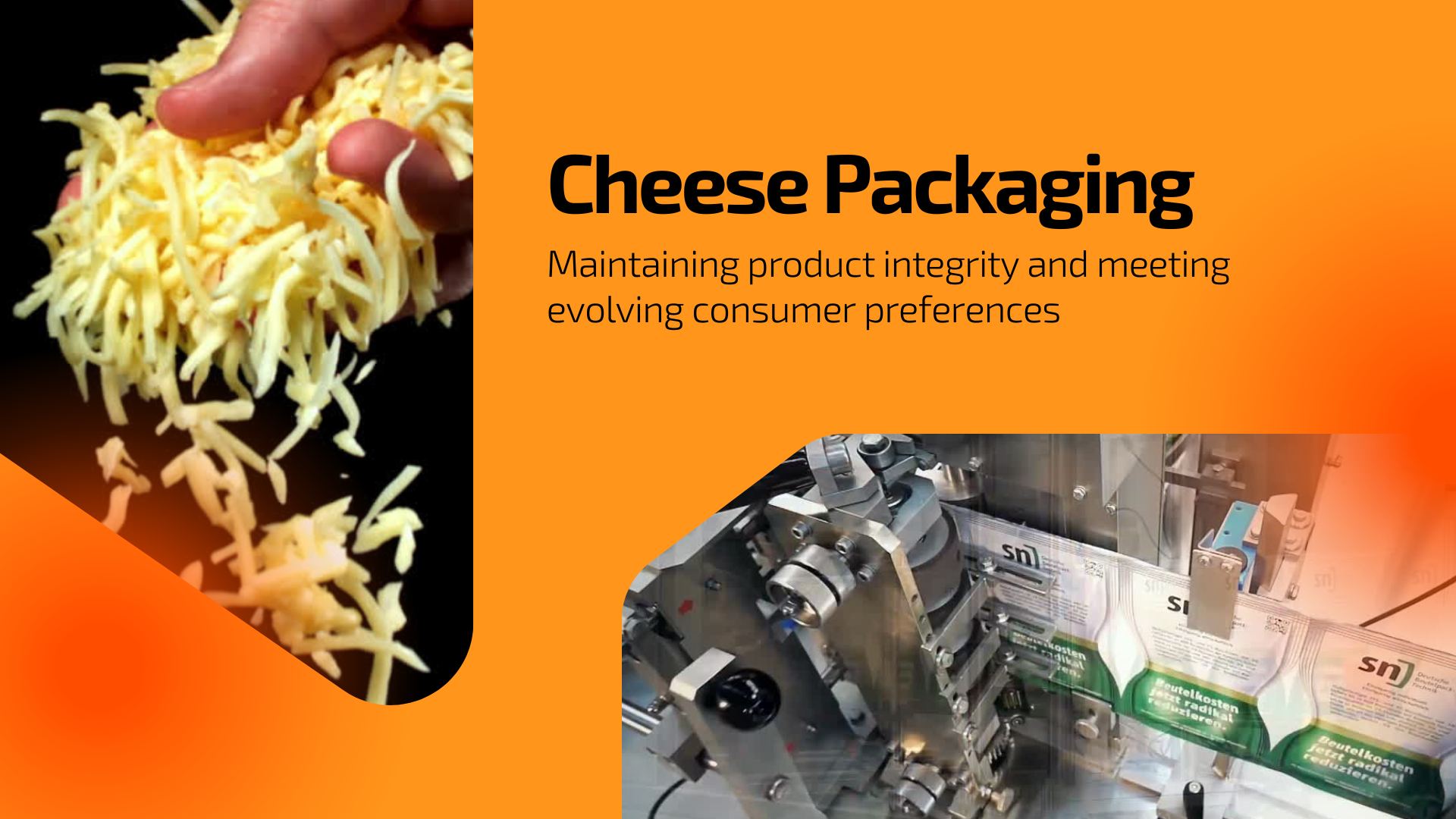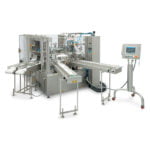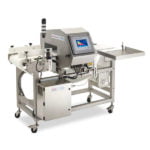
The Ultimate Guide to Cheese Packaging Solutions for Maximum Freshness
Dairy is a major industry in North America and globally. The global cheese packaging industry was valued at $3.7 billion in 2024 and is expected to reach $5.6 billion by 2034.
Consumer preferences are shifting toward convenient and sustainable packaging. Research shows that 65% of consumers prefer easy-to-open designs, and 60% value resealable features in cheese packaging.
Effective cheese packaging is imperative for maintaining product quality, extending shelf life, and satisfying consumer demands. The anticipated growth in this segment underscores the critical importance of packaging in cheese preservation. Proper packaging is not just beneficial; it actively safeguards cheese from external contaminants and meticulously regulates factors like moisture and oxygen levels which are vital for preventing mold growth and flavor deterioration.
For cheese producers, maintaining product integrity and meeting evolving consumer preferences requires investing in advanced packaging solutions. These solutions are essential in today’s market.
Selecting Cheese Packaging Machinery
Best practices include reviewing and identifying opportunities for improvement and increased efficiency in your production process.
- Determine the level of automation you need, your available floorspace, and compatibility between new and existing machinery
- Have a firm idea of the appropriate type of packaging material needed and the required speed for the packaging process required
- Determine the sizes or quantities of cheese products and packaging needed for your production
- Highlight any special instructions that may affect packaging, such as temperatures at the time of packaging or along the supply chain
- Invest in a fully washdown packaging machine that is specifically designed for high-quality performance, durability, and compliance with local food safety regulations
- Consider optional equipment from the onset. Have it installed or ensure it can be added to an existing system later to save time and money in the long run (laser coders, variable information printers, labelers, gas injection nozzles, etc.)
- Invest in quality products from a reputable OEM to ensure you will benefit from the added assurance of local technical service if you need assistance with these products in the future
- Build a contingency into your budget for any spare parts and maintenance needs that may arise unexpectedly
Additionally, you should be mindful of your budget and the long-term costs of owning and operating the cheese packaging machinery.
Cheese Packaging Operations and Hygiene
Good packaging practices are essential to meet the strict safety standards that govern the dairy industry. Cheese packaging machinery and handling must be implemented with strong hygiene control and validation measures. Packaging processes should also adhere to Good Hygiene Practices (GHPs) to protect against product contamination, bacterial growth, food allergies, and product decay. Ultimately, cheese producers need to ensure packaging quality and hygiene to ensure their products remain safe, fresh, and of high quality – not only for consumer health and satisfaction but also from a business sustainability point of view.
Good Hygiene Practices (GHP) Starts with these Steps
- Washdown Machinery: Machinery, containers, and equipment in direct contact should be fully washdown, meaning hollowed areas and niches are minimized, and the machinery can resist cleaning with a high-pressure spray, superheated water, and chemicals.
- Facility Sanitation: Facilities should be constructed with easily cleaned non-porous materials, and floors should be sloped for easy drainage. Ventilation systems are strategically positioned so airflow from contaminated areas cannot easily reach clean areas.
- Staff Cleanliness: Staff should wear sanitary protective equipment, be trained to understand the processing steps, and a sufficient amount of hand-cleaning areas should be available.
For more safe food handling practices and procedures visit the Canadian Food Inspection Agency or the U.S. Food & Drug Association

Types of Cheese Packaging
As a cheese manufacturer, there are many factors to consider when packaging your product. Cheese requires special packaging that is both functional and aesthetically pleasing. The type of cheese product you are packaging will also influence the type of cheese packaging machinery you should consider. The right packaging will make all the difference in the quality of your product, as well as its shelf life.
Thermosealed Packaging
Chunk, Block, or Sliced Cheeses
The most common type of cheese packaging is vacuum-sealed plastic multibarrier or semi-rigid film, which is ideal for keeping moisture out and preserving flavor. Vacuum sealing also helps protect against contamination from other foods and makes it easier to store cheese for extended periods. Vacuum-sealed plastic wraps can come in various sizes and colors, so you can find the perfect fit for whatever type of cheese you’re packaging.
Pouches and Bags
Diced or Shredded Cheeses
Other popular options are Vertical Films to form multiple bag shapes and sizes & Stand-Up Pouches. Both are excellent for delicate cheese products like shredded cheeses as they provide airtight packaging that seals out external environmental factors like moisture and oxygen, which cause spoilage. They also offer high resistance to puncture and abrasion and preserve product freshness on store shelves long after they are packaged.
Plastic Cup
Spreadable and Soft Cheeses
For this category of cheese product, packaging with more body is required. Polypropylene or polyethylene (PP or PE) flexible barrier containers provide an oxygen or light barrier, depending on the sensitivity of the product. Furthermore, they are cost-effective and easy to transport, making them ideal for packaging spreadable cheese.
Cheese Packaging Machinery
As a cheese manufacturer, you understand the importance of investing in quality equipment to produce safe, consistent products. Specialized packaging equipment is an invaluable addition to completing your production line, offering a suitable and cost-effective solution for taking your cheese from production to the consumer.
Thermosealers
Multibarrier or Semi-Rigid Film
Vacuum, MAP, or Skin thermosealing machines are designed to quickly seal packages containing fresh or frozen food items like cheese. These machines use heat-sealing technology to create airtight seals around packages that protect against spoilage while preventing moisture penetration. Vacuum sealers offer superior performance compared to traditional manual sealing methods such as twist ties or hand-operated clamps. They also require less time and effort than other sealing methods and can save you money in materials costs since they don’t require bulky packaging materials like bubble wrap or foam peanuts.
Pouches and Bags
HFFS machines are undoubtedly one of the best packaging solutions for shredded cheeses and squeeze pouch yogurts. Available is USDA washdown configuration with robust construction, easy maintenance, and reliable performance for long-term operations, HFFS machines feature intermittent motion filling and sealing as well as servo driven format change of the side and bottom seal frames. They quickly and efficiently package dairy products with an improved shelf life of more than 60 days, as well as being able to handle a wide variety of product sizes, shapes, and textures. Machines such as these can produce up to 270 bags per minute!
Pouches and Bags
VFFS machines offer superior protection because they quickly and efficiently package products in airtight bags or pouches – the perfect solution for protecting your delicate cheese products. Another major benefit of using a VFFS machine for cheese packaging is its ability to fill packages with precise amounts of product every cycle. This ensures that each package contains the right amount of cheese without waste or over-fill issues. VFFS machines also provide quick changeovers with just a few simple adjustments without compromising on speed or accuracy and can attain speeds of 100 bags per minute!
Pouches and Bags
Pre-made pouch packaging machines quickly and efficiently package cheese products such as sliced, shredded, and string cheese. The machine design ensures that the cheese is adequately sealed and protected from contamination and spoilage. Additionally, these machines can handle packaging a wide variety of pouch sizes and styles, allowing for greater flexibility in product packaging. Furthermore, these machines can fill and seal pouches at high speeds, making them ideal for large-scale production runs.
Plastic, PP, or PE Cups
Filling and sealing machines are helpful for packaging spreadable cheese products such as cream cheese, cottage cheese, and other soft cheese spreads. They are designed to fill the containers with the cheese product and seal them, ensuring the product is safe and protected from contamination. Furthermore, they can be adjusted to accommodate various containers, allowing maximum flexibility in packaging different types of cheese products.
Product and Brand Safety
Metal Detectors & X-Ray machines can detect contaminants such as metal fragments, glass shards, and plastic pieces that may be present in cheese products. These technologies are often used in together on a processing & packaging line to identify any metal, foreign objects or undesired cheese components in the product, such as mold or insects. Furthermore, they are capable of providing detailed information about the size, shape, and density of the contaminants or foreign objects, allowing for more accurate detection and identification.
Optional Equipment
Additional efficiency for product packaging
A host of optional equipment can be added directly on or adjacent to the primary packaging equipment to enhance your operations further.
- Induction Sealers: To a foil seal over the Plastic or PP, PE Cup before lidding, which seals in freshness.
- Labeling Equipment: For more artisanal primary packaging, apply top & bottom brand labels. For secondary packaging, apply handling instructions and traceability codes
- Marking and Coding Equipment: Print lot numbers, SKUs, barcodes, and etc.
- Gas Injection Nozzles: Inject inert gasses such as nitrogen to eliminate oxygen from the package
Better Cheese Packaging Efficiency with Automation
When selecting the best type of cheese packaging machinery for your business, it’s important to consider all factors such as functionality, efficiency and get a good idea of it’s overall cost cost. With careful consideration, planning, and the right OEM partner, you will be able to find the perfect solution that meets all criteria needed to ensure success well after the machine’s integration into your production line!
Tell us about your cheese manufacturing project and we will contact you!
6 Key Factors to Consider when Buying a Premade Pouch Filling Machine
Modern Pre-Made Pouch Baggers are growing in popularity with brand owners and retailers ov...
A Guide to Automated Bagging Machines
Dive into the realm of automated bagging machines! Discover the most common bagging soluti...
Accurate, Hygienic Liquid Fillers in North America
Cut product giveaway, streamline hygiene compliance, and handle complex textures with ease...












